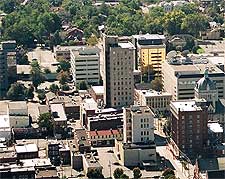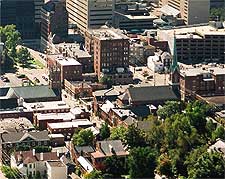Lexington History Facts and Timeline
(Lexington, Kentucky - KY, USA)

Even before Kentucky became a state of the Union in 1792, frontiersmen had settled along a local creek at McConnell Springs, having heard of the victory of the colonists during the first skirmishes of the American War of Independence (1775 to 1783). In honor of the victory at Lexington, Massachusetts, the frontiersmen named the settlement Lexington, although building was delayed for four years due to troubles with local Native Indians.
In 1779, a permanent settlement was established with the help of military from a nearby fort, with log cabin homes, a blockhouse and a stockade constructed.
Rapid Development in a Slave-oriented Society
Newly built Lexington proved its worth early on in its history, fighting off attacks from both the British and the American Indians during the last gasp of the American Revolution. Lexington was formally established on 6th May 1872.
Within 30 years, the town was famous in the region for its slave-based wealth and culture, with the construction of many heritage buildings, some of which are still standing today as a memorial to the city's golden age. The town's population grew rapidly to 7,000, although cholera outbreaks between 1833 and 1850 decimated the towns people, forcing the wealthy to flee to surrounding rural areas.

Divided Loyalties
Oddly for a slave-owning society, the start of the American Civil War in 1861 saw divided loyalties among residents of Lexington and Kentucky State. Motivated by the Confederate attack on Fort Sumter in South Carolina, Confederate volunteers marched through the city on their route south. At the same time, local Unionist and banker David A. Sayer was organizing covert arms shipments and distributing weapons to his circle.
In addition, in an attempt to keep the crucial state neutral, local militia companies were formed, and both the Union and Confederacy presidents requested troops from Kentucky. Both were refused, but the dichotomy was settled in the 5th August 1861 elections, as the Unionist candidates won hands down.
The Civil War History
Due to its commanding location, Kentucky, including Lexington, bore the full brunt of hostilities, with the Union Army based in and outside the town, and the Confederate rendezvous points and camps a few days' march away. By 1862, conflicts raged across the state. Lexington prepared for a Confederate invasion, destroying stores and ammunition during a Union retreat.

A Confederate army of 11,000 occupied the city on 2nd October, but left six days later, with Union forces returning on the 18th. However, a subsequent Confederate raid re-equipped a cavalry troop with fresh horses, weapons and ammunition for the long journey home.
By the following winter, escaped slaves were arriving in Lexington, sparking the formation of eight African-American Union regiments by 1884. Enlisted Kentucky slaves were automatically given their freedom, with emancipated men forming some 12 percent of the Union forces by the time the Civil War ended in 1865. During the war's last days, Confederate troops attacked, looted and burned the town once more.
20th Century to the Present Day
At the time of Lexington's early 20th-century history, most of the wealth from the East Kentucky coal mining operations passed through the city, spurring growth and development, especially in the commercial downtown district.
Always known for the quality of its horses, the city and its horse breeding led to its new nickname of 'Horse Capital of the World'. Nowadays, the epithet still holds true, with racing stable owners and trainers from across the world arriving in Lexington annually for horse sales and race events.
 Even before Kentucky became a state of the Union in 1792, frontiersmen had settled along a local creek at McConnell Springs, having heard of the victory of the colonists during the first skirmishes of the American War of Independence (1775 to 1783). In honor of the victory at Lexington, Massachusetts, the frontiersmen named the settlement Lexington, although building was delayed for four years due to troubles with local Native Indians.
Even before Kentucky became a state of the Union in 1792, frontiersmen had settled along a local creek at McConnell Springs, having heard of the victory of the colonists during the first skirmishes of the American War of Independence (1775 to 1783). In honor of the victory at Lexington, Massachusetts, the frontiersmen named the settlement Lexington, although building was delayed for four years due to troubles with local Native Indians.
 A Confederate army of 11,000 occupied the city on 2nd October, but left six days later, with Union forces returning on the 18th. However, a subsequent Confederate raid re-equipped a cavalry troop with fresh horses, weapons and ammunition for the long journey home.
A Confederate army of 11,000 occupied the city on 2nd October, but left six days later, with Union forces returning on the 18th. However, a subsequent Confederate raid re-equipped a cavalry troop with fresh horses, weapons and ammunition for the long journey home.